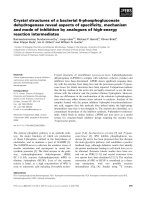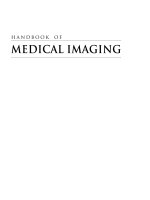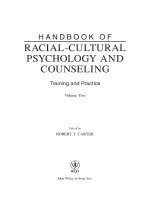Handbook of biophilic city planing and deaign
Bạn đang xem bản rút gọn của tài liệu. Xem và tải ngay bản đầy đủ của tài liệu tại đây (12.1 MB, 314 trang )
Handbook
of Biophilic
City Planning
& Design
TIMOTHY BEATLEY
Handbook of Biophilic City Planning and Design
Handbook of Biophilic
City Planning and Design
Timothy Beatley
Washington | Covelo | London
Copyright © 2016 Timothy Beatley
All rights reserved under International and Pan-American Copyright Conventions. No part
of this book may be reproduced in any form or by any means without permission in writing
from the publisher: Island Press, 2000 M Street, NW, Suite 650, Washington, DC 20036
ISLAND PRESS is a trademark of the Center for Resource Economics.
Library of Congress Control Number: 2016938091
Printed on recycled, acid-free paper
Manufactured in the United States of America
10 9 8 7 6 5 4 3 2 1
Keywords: Biodiversity, Biophilia, Biophilic Cities Network, bird-safe buildings, Birmingham
(United Kingdom), carbon footprint, climate change, ecosystem, garden, greenbelt, green
infrastructure, Green Streets Initiative, health, Intertwine, Khoo Teck Puat Hospital,
Milwaukee, nature, nature center, Oslo, park, parklet, Portland, resilience, restoration, San
Francisco, Singapore, Stephen Kellert, Sutton Park, urban ecology, vertical garden, VitoriaGastiez (Spain), watershed, Wellington (New Zealand), Zealandia
To Anneke, Caro, and Jadie
Contents
List of Case Studies .............................................................................................................. xi
Preface .................................................................................................................................xv
Acknowledgments................................................................................................................xix
PART 1: THE BACKGROUND AND THEORY OF BIOPHILIC CITIES ................................. 1
Chapter 1: The Power of Urban Nature: The Essential Benefits of Biophilic Urbanism .... 3
Chapter 2. Understanding the Nature of Biophilic Cities ................................................ 13
Chapter 3. The Urban Nature Diet: The Many Ways That
Nature Enhances Urban Life ........................................................................... 33
Chapter 4. Biophilic Cities and Urban Resilience ............................................................ 41
PART 2: CREATING BIOPHILIC CITIES: EMERGING GLOBAL PRACTICE ...................... 49
Chapter 5. Singapore City, Singapore: City in a Garden .................................................. 51
Chapter 6. Milwaukee, Wisconsin: From Cream City to Green City ............................... 67
Chapter 7. Wellington, New Zealand: From Town Belt to Blue Belt ................................ 75
Chapter 8. Birmingham, United Kingdom: Health, Nature, and Urban Economy ......... 85
Chapter 9. Portland, Oregon: Green Streets in a River City............................................. 93
Chapter 10. San Francisco, California: Biophilic City by the Bay.................................. 103
Chapter 11. Oslo, Norway: A City of Fjords and Forests ................................................ 119
Chapter 12. Vitoria-Gasteiz, Spain: Nature in the Compact City .................................. 131
PART 3: A GLOBAL SURVEY OF INNOVATIVE PRACTICE AND PROJECTS .................. 139
I. Biophilic Plans and Codes ........................................................................................... 141
II. Citizen Science and Community Engagement .......................................................... 145
III. Biophilic Architecture and Design ............................................................................ 149
IV. Restoring and Reintroducing Nature into the City ................................................... 173
V. Other Biophilic Urban Strategies ................................................................................ 221
PART 4: SUCCESSES AND FUTURE DIRECTIONS .......................................................... 225
Chapter 13: Lessons from the World’s Emerging Biophilic Cities ................................. 227
Chapter 14: Overcoming the Obstacles and Challenges That Remain .......................... 245
Chapter 15: Conclusions: Reimagining Cities of the Future.......................................... 255
Resources .......................................................................................................................... 261
References ......................................................................................................................... 265
Index ................................................................................................................................ 279
List of Case Studies
I. BIOPHILIC PLANS AND CODES...................................................................................141
Green Roof Bylaws, Toronto, Ontario, Canada ....................................................141
Greenest City Action Plan, Vancouver, British Columbia, Canada .....................142
II. CITIZEN SCIENCE AND COMMUNITY ENGAGEMENT ............................................145
Camping in Urban Parks, New York City, New York ............................................145
Urban Slender Loris Project, Bangalore, India ......................................................146
III. BIOPHILIC ARCHITECTURE AND DESIGN ...............................................................149
A. Bird-Friendly Urban Design .....................................................................................149
Aqua Tower, Chicago, Illinois ...............................................................................149
B. Biophilic Factories, Business Parks ...........................................................................151
Hero MotoCorp Garden Factory and Global Parts Center, Neemrana, India ......151
Park 20|20, Amsterdam, Netherlands ...................................................................152
C. Green Rooftops and Walls .......................................................................................154
Green Roofs, Chicago, Illinois ..............................................................................154
Azoteas Verdes, Mexico City, Mexico ..................................................................155
GreenSkins, Fremantle, Perth, Western Australia .................................................156
One Central Park, Sydney, Australia .....................................................................159
D. Green Terraces and Towers/Vertical Nature...............................................................160
Stacking Green, Ho Chi Minh City, Vietnam .......................................................160
Jardines Verticales, Mexico City, Mexico ..............................................................161
300 Lafayette Street, SOHO, New York City .........................................................162
Via Verde, Bronx, New York City ..........................................................................163
Bosco Verticale, Milan, Italy .................................................................................166
E. Healing Spaces/Health and Nature ...........................................................................167
Spaulding Rehabilitation Hospital, Boston, Massachusetts..................................167
Credit Valley Hospital, Carlo Fidani Peel Regional Cancer Center,
Mississauga, Ontario, Canada .....................................................................168
Healey Family Student Center, Georgetown University, Washington, DC ..........169
F. Multisensory Biophilic Design ..................................................................................171
Phipps Conservatory and Botanical Gardens, Pittsburgh, Pennsylvania .............171
IV. RESTORING AND REINTRODUCING NATURE INTO THE CITY ..............................173
A. Rivers and Riparian Nature; Blue Urbanism .............................................................173
Revitalizing the Los Angeles River, Los Angeles, California .................................173
James River Riverfront Plan, Richmond, Virginia ................................................175
Cheonggyecheon Stream Restoration Project, Seoul, South Korea ......................177
St. Louis Great Rivers Greenway District’s River Ring, St. Louis, Missouri...........178
El Parque del Agua Luis Buñuel, Zaragoza, Spain .................................................179
B. Trees and Urban Forests ...........................................................................................181
RE:LEAF/Street Tree Initiative/Mayor’s Street Tree Program,
London, United Kingdom...........................................................................181
Urban Forest Strategy, Melbourne, Australia ........................................................182
C. Greenways, Greenbelts, Urban Trails........................................................................183
Urban Trail Network, Anchorage, Alaska ..............................................................183
Chengdu’s Ecological Belt and Garden City Vision, Chengdu, China ................184
Trilha TransCarioca (TransCarioca Trail), Rio de Janeiro, Brazil ...........................187
D. Green Alleys/Ecological Alleyways ...........................................................................188
Green Alley Program, Austin, Texas......................................................................188
Green Alleys, Montreal, Quebec, Canada .............................................................191
E. Green Infrastructure and Urban Ecological Strategies ................................................193
Costanera Norte, Buenos Aires, Argentina ...........................................................193
Chicago Wilderness, Chicago, Illinois ..................................................................194
Houston Wilderness, Houston, Texas ...................................................................195
Green Grid, London, United Kingdom ................................................................196
McDowell Sonoran Preserve, Phoenix and Scottsdale, Arizona ...........................197
F. Innovative Parks and Nature Areas ..........................................................................200
Pocket Parks Program, London, United Kingdom ................................................200
Natur-Park Südgelände, Berlin, Germany .............................................................201
Gowanus Canal Sponge ParkTM, Brooklyn, New York City, New York .................203
Qiaoyuan Park, Tianjin, China .............................................................................204
G. Water Design in the Biophilic City ...........................................................................206
Healthy Harbor Initiative, Baltimore, Maryland ..................................................206
Buffalo Bayou, Houston, Texas .............................................................................207
Green City, Clean Waters Program, Philadelphia, Pennsylvania .........................208
Paley Park, Midtown, New York City, New York ..................................................210
H. Wildlife Corridors and Urban Biodiversity Planning..................................................211
Urban Biodiversity, Cape Town, South Africa ......................................................211
Wildlife Passages, Edmonton, Alberta, Canada ....................................................212
Urban National Park Planning, Nairobi, Kenya ...................................................213
Milkweeds for Monarchs, St. Louis, Missouri .......................................................214
I. Food and Edible Urban Landscapes ..........................................................................217
Philadelphia Orchard Project, Philadelphia, Pennsylvania ..................................217
Beacon Food Forest, Seattle, Washington .............................................................218
V. OTHER BIOPHILIC URBAN STRATEGIES ....................................................................221
A. Nature and Favelas, Disaster Recovery .....................................................................221
Sitie Ecological Park, Rio de Janeiro, Brazil...........................................................221
Martissant Park, Port-au-Prince, Haiti...................................................................222
B. Nature Centers ........................................................................................................224
Eden Place Nature Center, Chicago, Illinois .........................................................224
Preface
This handbook is about the power of nature to create better, more livable, sustainable, and resilient urban neighborhoods and environments.
It is intended to be useful in several ways. First, it provides a comprehensive guide
to biophilic urbanism and urban practice, with a wealth of information about how
cities can integrate nature into their planning and design processes and projects.
Second, it offers inspiration for how cities of the future might look, feel, and
function. As we move into the urban age, we are desperately in need of new models,
examples, and frames of reference for the relationship between urban and natural
environments. This book also provides more than a modicum of hope in an age
where climate change and global environmental degradation cause concern about
the future of human and nonhuman life on Earth. While the tools, ideas, strategies,
and emerging urban practices reported in these pages do not represent a complete
antidote to these global challenges—indeed, what book could?— they are a considerable step in the right direction.
This book synthesizes and expands on the research conducted by the Biophilic
Cities Project at the University of Virginia. Begun in 2011, the Project sought to
apply the ideas, principles, and practices of the emerging biophilic design movement
to the larger scale of cities and metropolitan areas. Focused initially on seven partner
cities within the United States and around the world (later expanded to ten cities
included in the 2013 Biophilic Cities exhibition and launch event), researchers, practitioners, and politicians collaborated to develop ideas about what a biophilic city is
and what it could be in the future.
Much of the work in the initial years of the project focused on fleshing out the
concept of biophilic urbanism, and telling the stories of cities leading the way. In
October 2013, the Project expanded with the launch of a global Biophilic Cities
xv
xvi
Preface
Network, which is intended to help foster a common agenda and a mechanism for
sharing insights and collaborating across cultures and geographic boundaries to reimagine a planet of cities that not only value and respect nature but also make it a
centerpiece of future design and planning.
Building from the Biophilic Cities Network’s efforts, this handbook is intended
to advance and solidify some of these nascent ways of understanding and speaking
about nature in cities. While we continue to understand and embrace the value of
concepts and language—like sustainable cities, resilient cities, regenerative cities—we
believe the emphasis on biophilic cities is a useful and necessary addition.
Why? Don’t we already speak compellingly of green cities and green infrastructure? Yes, but those descriptors fall short in significant ways. Greening cities is more
often understood in terms of the many ways that buildings and neighborhoods can
reduce energy consumption and lower ecological footprints. These are important
goals, but they don’t tell us much about the kinds of neighborhoods, communities,
and cities we wish to live in, and they understand nature as only one of many green
design and planning arrows in the quiver.
Biophilic, in its emphasis on both the natural world and living things (bio) and
the connections with and love of nature (philia), captures more squarely what cities
and city planning and design need today. We need something more than nature that
serves as infrastructure—we need to speak compellingly and passionately about the
need to nurture, protect, care for, and connect with nature. We need to connect with
nature for our health and well-being, as scientific evidence increasingly tells us, and
biophilic cities captures this importance of urban nature in a way that other contemporary words or language cannot.
What follows are many stories and examples of emerging practice. Part 1 summarizes key ideas, theory, and literature that define biophilic cities and biophilic urbanism.
Parts 2 and 3 represent the bulk of the handbook. Part 2 contains full-length chapters
on the main cities that the Biophilic Cities Project research has focused on for several
years. These cities are also inaugural cities in the new global Biophilic Cities Network.
Part 3 features a rich array of shorter examples of urban biophilic innovation from
cities around the world. Part 4 presents reflections and lessons about how to advance
urban biophilia and biophilic cities. The book closes with a bibliography and an
extensive list of resources, including leading books and online resources.
Together the chapters provide a comprehensive understanding of both the theory
and the practice of biophilic cities. It is a practical mix of ideas and principles, current urban practice, and future aspirations. The reader will see that much has already
been done, or is under way, in cities around the world.
Preface
xvii
These are daunting times in terms of the challenges cities face in the decades
ahead, but they are also exciting times, when cities are making room for nature,
appreciating the importance of nature to health and well-being and to leading meaningful lives.
Acknowledgments
There are many people to thank for help in writing this book and in conducting the
research that went into these chapters and cases. Many specific individuals have helped
collect and supply data and information. Special thanks go to our main contacts and
collaborators in the partner cities. While this is by no means a complete list, we owe
a special thanks to the following individuals in these cities: Lena Chan (Singapore);
Mayor Celia Wade-Brown, Amber Bill, and Charles Dougherty (Wellington); Mike
Houck, Matt Burlin, and Linda Dobson (Portland); Matt Howard, Erick Shambarger,
and Marcia Caton Campbell (Milwaukee); Per Gunnar Roe and Mark Luccarelli (Oslo);
Sabine Courcier and Josee Duplessis (Montreal); Scott Edmondson and Peter Brastow
(San Francisco); Nick Grayson and Rob MacKenzie (Birmingham, UK); Cecilia Herzog (Rio de Janeiro); Luis Andres Orive and Rebeca Dios (Vitoria-Gasteiz); and Craig
Thomas and David Pijawka (Phoenix), among many others. Other individuals who
have been very helpful and have lent support to the biophilic cities idea include Julia
Africa, Bill Browning, Herbert Dreisetl, John Hadidian, Stephen Kellert, Stella Tarnay,
Helena van Vliet, Catherine Werner, and Jennifer Wolch, among others.
Special thanks must also be given to the Summit Foundation of Washington, DC,
and to its director of sustainable cities, Darryl Young, who provides extensive financial (and moral) support for the work, and for the emerging global network of cities.
Financial support for this research was provided initially under the grant “Biophilic
Urbanism: Global Methods and Metrics,” and was followed by additional support to
develop the project’s web page and newly launched Biophilic Cities Network.
Significant financial support for the Biophilic Cities Project and the event launching the global Biophilic Cities Network was also provided by the George Mitchell
Foundation. George Mitchell sadly passed away in 2013, but he will be remembered
as a leader and catalyst for sustainable, biophilic design, as evidenced in his work
xix
xx
Acknowledgments
with Ian McHarg in designing and building the Woodlands, a green new town ahead
of its time. It was a pleasure to get to know George Mitchell, and an honor to have
his personal and financial support for the work we have been doing in green urbanism and biophilic cities.
Special thanks are also due Professor Peter Newman, of Curtin University, who
has been a partner and close colleague in developing the ideas of biophilic cities and
biophilic urbanism. Many of the cities we have examined here, and the projects and
people profiled, are due to Peter’s suggestions and generous sharing of his immense
network of global contacts.
A number of graduate students in the Department of Urban and Environmental
Planning, at the University of Virgina, have helped with this project along the way,
either working directly on the information and cases presented here, or on some other
aspect of the Biophilic Cities Project over the years. These current and former students
include Holly Hendrix, Harriett Jameson, Sarah Schramm, Amanda Beck, Mariah Gleason, Briana Bergstrom, Dita Beard, and JD Brown, among others. Special thanks are
owed to Carla Jones and Julia Triman who read and edited all parts of this book.
Several of the chapters to follow draw from earlier writing. Some material has
appeared earlier in our Biophilic Cities blogs. Several chapters in part 2 draw from
earlier published work. An earlier version of the Singapore chapter was published in
SiteLines (Foundation for Landscape Studies), and a version of the Oslo chapter was
published earlier in the book Green Oslo: Visions, Planning and Discourse (Ashgate),
though both have been substantially modified. Two of Beatley’s EverGreen columns
written for Planning Magazine (longer drafts) make up portions of the chapters on
Birmingham and San Francisco.
PART 1:
The Background and Theory
of Biophilic Cities
This first section of the handbook lays some essential groundwork in exploring evidence of the need for biophilic cities, their different features and dimensions, and
the ways in which they help advance resilience and sustainability.
Chapter 1 describes the history of biophilia and its application to buildings and
cities, and reviews the emerging and growing evidence about the benefits and value
of nature (health, psychological, economic). Chapter 2 explores more specifically
what a biophilic city is, or could be—since this field is still young—and its various
features and dimensions. Chapter 3 considers the different kinds of nature in
cities and the ways in which nature might be experienced and enjoyed in cities.
It introduces the idea of the urban nature diet as a framework for thinking about
the kinds and extent of nature needed in urban environments. Finally, chapter 4
makes the explicit argument that the actions and strategies we undertake to make
cities more biophilic will also help to make them more resilient and sustainable. It
presents a model of the different pathways, direct and indirect, by which biophilic
design and planning interventions can influence health and resilience.
Timothy Beatley, Handbook of Biophilic City Planning and Design,
DOI 10.5822/ 978-1-61091-621-9, © 2016 Timothy Beatley.
1
The Power of Urban Nature:
The Essential Benefits of Biophilic Urbanism
Human beings need contact with nature and the natural environment. They need
it to be healthy, happy, and productive and to lead meaningful lives. Nature is not
optional, but an absolutely essential quality of modern urban life. Conserving and
restoring the considerable nature that already exists in cities and finding or creating
new ways to grow and insert new forms of nature are paramount challenges of the
twenty-first century.
We know, moreover, that creating sustainable, resilient cities will necessitate the
design qualities of compactness and density. To achieve those urban qualities that
allow us to walk, to invest in and use public transportation, to reduce our energy and
carbon footprints, cities will definitely need to be denser and more compact. That
presents challenges to integrating nature, and finding ways to ensure that all urban
residents have the daily, ideally hourly, contact with the natural world that they need.
We live in the age of cities, this is clear. Some 54 percent of the world’s population now lives in cities, and that percentage is already much higher in American and
European cities. Globally we have seen spectacular growth in urban population in
a mere few decades. The number of people living in cities, according to the United
Nations, has increased from 756 million in 1950 to nearly 4 billion in 2014. The percentage of the world’s population living in cities is expected to approach 70 percent
by 2050 (United Nations, 2014).
Cities and metropolitan areas represent governmental entities and geographical
scales of concern that best match the global times we are in. As Parag Khanna, writing in the journal Foreign Policy (Khanna, 2010) observes: “The 21st century will
Timothy Beatley, Handbook of Biophilic City Planning and Design,
DOI 10.5822/ 978-1-61091-621-9_1, © 2016 Timothy Beatley.
3
4
Handbook of Biophilic City Planning and Design
Figure 1.1. A major task for modern cities is to become more compact and dense, but at the
same time foster closer connections to nature. Cities like Singapore have done much to show
how this is possible, and to imagine a dense city immersed within nature. Singapore, shown
here, has recently changed its city motto from “garden city” to “city in a garden.” Credit: Photo
by Tim Beatley.
not be dominated by America or China, Brazil or India, but by the city. In an age
that appears increasingly unmanageable, cities rather than states are becoming the
islands of governance on which the future world order will be built. This new world
is not—and will not be—one global village, so much as a network of different ones.”
Cities will need to take significant steps to enhance and regrow local and regional
nature (fig. 1.1), but also serve as leaders in helping other cities to do the same and
to provide leadership in global conservation.
Biophilia
The concept of biophilia is the foundation for what follows in this handbook.
Although the term was originally coined by German social psychologist Erich
Fromm, Harvard entomologist E. O. Wilson deserves much credit for this idea, and
for his career of tirelessly working on behalf of the natural world. Wilson famously
defines biophilia as “the innately emotional affiliation of human beings to other living organisms. Innate means hereditary and hence part of ultimate human nature”
The Power of Urban Nature
5
(Wilson 1984, 31). Innate connections and affiliation are hardwired in us, though
Stephen Kellert, emeritus professor at Yale and a major figure in the development
of the idea of biophilia, believes them to be “‘weak’ genetic tendencies,” essentially
needing cultural reinforcement and exercising (rather like a muscle)(Kellert, 2005).
Biophilia argues that we carry with us predispositions to certain things in our
modern landscapes that, over evolutionary history, helped with our survival. Prospect and refuge theory holds that we are predisposed to prefer or desire wide-vista
landscapes (prospect), because they delivered survival advantages, and refuge (caves
and cliffs, for instance) for similar reasons. We also prefer water and coastal environments for these reasons (more about this later).
Stephen Kellert along with others, notably Judith Heerwagen, Roger Ulrich, and
Bill Browning, have done much to advance and further expound on the idea of biophilia. Their work has helped cultivate and stimulate the application of these ideas
in architecture (Kellert, Heerwagen, and Midor 2008).
Increasing Evidence of the Healing Power of Nature
While there is a long history of celebrating and emphasizing the value and benefits
of parks and nature (from Frederick Law Olmsted to Ian McHarg), the last decade
has seen an explosion of scientific evidence and scholarly research documenting and
demonstrating the various ways exposure to nature helps us. Dr. Kathleen Wolf, at
the University of Washington, has analyzed an impressive 2800 articles describing
research on the relationship between green space and health and concludes that the
vast majority of this literature is from the 2000s and 1990s. Relatively few articles
were published on this topic in the 1970s or 1980s, showing just how recent this
trend in scholarship has been (Wolf and Flora 2010).
There is considerable and growing research, then, showing that contact with
nature provides a wide range of positive mental and physical benefits. Exposure to
nature helps reduce stress and boosts our cognitive performance. The early work of
Rachel and Stephen Kaplan, on the Attention Restoration Theory (ART) emphasizes
the important role that nature plays in helping us recover from the stress and emotionally taxing aspects of so-called directed attention (where we are concentrated
and focused on accomplishing a task [see Kaplan and Kaplan 1989]).
Roger Ulrich’s study of the healing power of nature is a watershed study for many
in the biophilic design world. His study of patients’ recovery from gallbladder surgery was one of the first to show in an empirically rigorous way that natural features
could have recuperative power. More specifically, this research found that patients
with hospital rooms that looked out on trees, compared with those with rooms that









